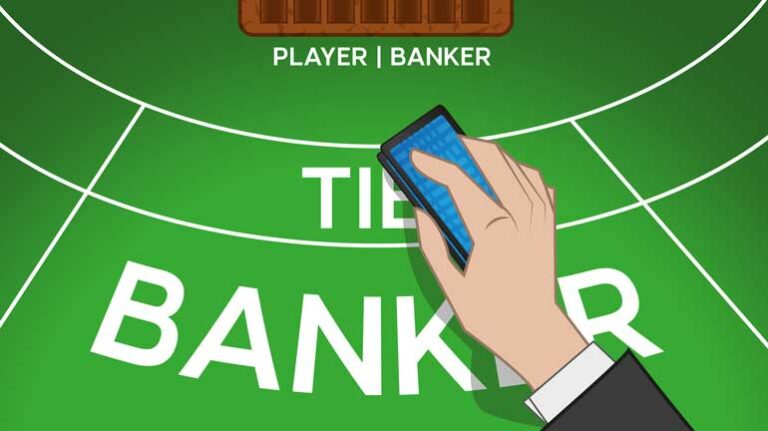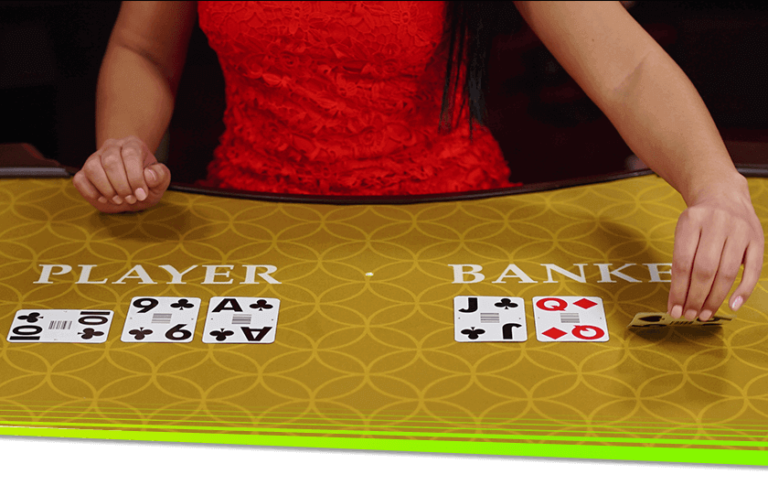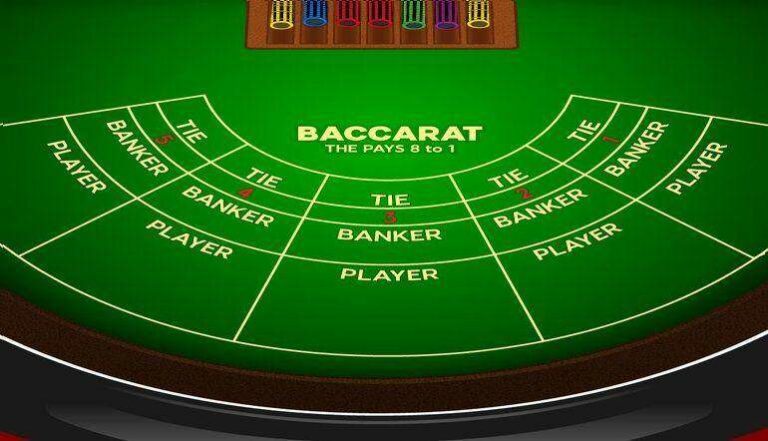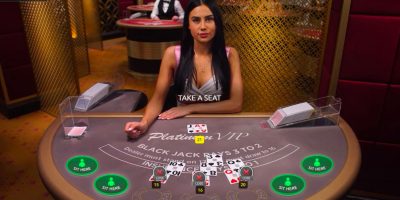As casinos move more and more toward automation gaming I’d like to review how the stadium version of Blackjack works. Here we will go over how this variant of the game works and more importantly how the community cards are utilized to settle the hands.
First we will review and summarize the rules of Stadium Blackjack. I’ll go through a sample hand and show you how the community cards are dealt and utilized by the players’ and the dealer. Rule 5 and 6 are particularly important. The key points have been bolded and put in italics.
Stadium Blackjack Rules
Stadium Blackjack is the variant of Blackjack where each player places a wager on their own electronic terminal. The result of each players’ game is determined by a live dealer utilizing community cards to reconcile player decisions.
- The (live) dealer will begin the betting round by pressing “New Game” on the dealer terminal touch screen.
- Each player places a wager on the main betting location, various side-bet can be added by the casino and the player can bet them.
- When the countdown timer expires, the dealer will deal one card on the layout to the “Player” location, one to the “Dealer” location, and a second card to the “Player” location.
- The players will then be able to make their decisions based on their two cards vs. the dealer’s one card.
- Each player terminal makes an independent decision on that hand.
- After all player decisions have been made, the dealer terminal prompts the dealer to draw a card and place it in the “Community” location on the layout.
- For players that hit their original hand, this card becomes their hit card.
- For Players that split their original hand, this (same) card becomes the next card on the first split hand.
- For players that Doubled Down, this (same) card becomes their double down card.
- For players that stood their original hand, this (same) card becomes the dealers’ second card.
- For players who have split or hit, additional decisions continue and the dealer will continue to draw cards as prompted to the “Community” location on the layout until such time that all active player hands have been reconciled in addition to the resulting dealer hands that occur based on the decisions made.
- The Dealer then presses “Confirm” to end the round. Pays and Takes are done automatically by the system.
If Player A asks for a hit and receives Community Card No. 2, the latter will not be dealt to the dealer’s hand that is competing against Player A’s hand. This will become clear as we through a sample hand.
Below is an example of a hand.
Sample Hand
- Players’ Hand is 8-8
- Dealers’ up-card is a 10
- There are three active players.
After the dealer deals the two cards to the Player’s Hand and one card for their hand, they wait until all the players have independently made their playing decisions before dealing the first Community Card. In Stadium Blackjack, every player starts with the same hand, in this example a pair of 8s, and then independently each player decides how they want to play the hand against the dealer’s up-card, in this example the card has a 10 value.
Suppose that the three active players make the following playing decisions:
- Player A Stands on the 8-8
- Player B Hits his 8-8 and
- Player C Split the 8s.
Here are how the player’s hands, and subsequently the dealer’s hand are reconciled. The table below summarizes the cards in each hand.

A look at the Community Cards
After each player decides how to play their hand, the dealer will draw one card from the Continuous Shuffle machine and place it in the area labeled Community Cards. Let’s assume the first community card was a 5. This is in the second column in the table below. Here’s how the hands will settle:
- For Player A (who stood on 16), the 5 becomes a draw card to the dealer’s 10, giving a dealer’s hand a 15 against Player A.
- For Player B, the same Community Card (5) becomes a draw card to his 16 (because he hit), giving him a hand that totals 21 (16 + 5 = 21). Player B then indicates on his console he wants to stand. (The dealer’s hand for Player B is still a 10.)
- For Player C (who decided to split his 8s), the same Community Card (5) becomes a draw card to his first split hand. Player C’s first split hand now totals 13 (8 + 5 = 13).
- The dealer deals a 2nd Community Card and it is an Ace. This card becomes:
- A draw card to the dealer’s hand against Player A. (Dealer now has 16: 10 + 5 + A = 16).
- A draw card for the dealer’s hand against Player B, giving the dealer a blackjack (10 + A = BJ).
- A draw card to Player C’s first split hand, giving him a total of 14 (8 + 5 + A = 14).
- The dealer deals a third Community Card and it is a 7. This card becomes:
- Another draw card for the dealer’s hand against Player A, giving the dealer a 23 (10 + 5 + A = 7 = 23). The dealer’s hand against Player A busts; therefore, Player A wins (standing on 16).
- The 7 becomes another draw card for the first split hand for Player C, giving him 21 (8 + 5 + A + 7 = 21). Player C stands with 21 on the first split and hits the second split.
- The dealer deals a fourth Community Card and it’s a 10. This card becomes:
- A draw card for Player’s C second split, giving him 18 (8 + 10 = 18). Player C stands with 18 on the second split hand.
- The dealer deals a fifth Community Card and it’s a 5. This card becomes:
- A draw card for the dealer’s hand against Player C, giving the dealer a 15 (10 + 5 = 15).
- A draw card for the dealer’s hand against Player C, giving the dealer a 15 (10 + 5 = 15).
- The dealer deals a sixth Community Card and it’s an 8. This card becomes:
- Another draw card for the dealer’s hand against Player C, giving the dealer a total of 23 (10 + 5 =8 = 23). Dealer busts.
- A draw card for Player’s C second split, giving him 18 (8 + 10 = 18). Player C stands with 18 on the second split hand.
Final result
- Player A, who stood with 16, won because the dealer busted.
- Player B, who had a 21, lost to a dealer’s blackjack.
- Player C, who split and wound up with 21 on one split and 18 on the other split, won both split hands because the dealer busted.

From the same starting hand (pair of 8s against a dealer 10), each player ended up with a different final hand against a different dealer’s hand (except in this example, the A and C dealer’s hand happened to be the same). This is what makes Stadium Blackjack different and some say more confusing than traditional Blackjack.
Important considerations
Some other points about Stadium Blackjack to remember:
- If a player splits or doubles and the dealer subsequently has a blackjack, the player only loses his original wager (the second bet made in splitting or doubling is returned to the player).
- The game uses a continuous shuffler in most cases but can also be dealt from a shoe.
- Casinos have a lot of flexibility in choosing the parameters offered – they can determine the number of decks of cards, the dealer drawing rules, the payoff for a blackjack, and the minimum and maximums of each bet offered, among other things.
- Currently, there are Stadium Blackjack installations at various casinos around the country:
- The Venetian pays 6-5 for a player blackjack. At Barona, Creek, and Mohegan Sun the blackjack pays 3-2. (Note: The blackjack payout is configurable by the casino. Therefore, the Venetian installation decided to pay only 6-5 whereas other properties pay 3-2.)
- Players can use the same basic playing strategy to play their hand as they would on a traditional blackjack game – nothing in the game differs from a live table, and all the rules are configurable by the casino with most or all of them being the same as found at a live game.
Stadium Blackjack is the same but different from traditional Blackjack. At the very least it’s more complicated than the traditional version of the game. So whether the game is good or bad for the player is a matter of opinion. In my opinion any game that uses a 6:5 payout as well as a continuous shuffle machine is always bad for the player.




















